| 1 – 30/6: Budapest – Gyongyos, 79km |
Visualizza balcani1 in una mappa di dimensioni maggiori
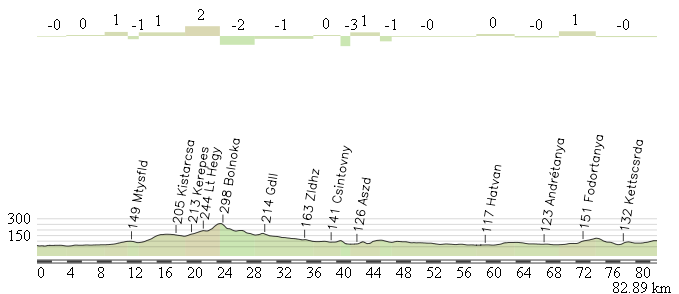
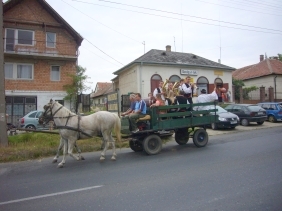
Rosamunda
La giornata non inizia sotto i migliori auspici: sul treno da Venezia mi hanno svegliato almeno due volte ad ogni frontiera per cui ho dormito poco e a tratti; mi accorgo che 3 borracce sono sparite, probabilmente sono cadute dal pacco in cui avevo chiuso la bici, che si era aperto strisciando per terra in uno dei cambi treno del giorno precedente. A Budapest devo assolutamente ricomprarle e necessito quindi sapere dove trovarle. Come al solito chiedere ad un ciclista si rivela la mossa vincente: c’è una famigliola in bicicletta che mi indica rapidamente un posto, fortunatamente lungo la strada. Trovo le borracce al centro commerciale ARKAD in un grande negozio di articoli sportivi al piano terra, non perdo tanto tempo ma la partenza effettiva è intorno alle 12 (il treno era arrivato alle 11). La strada n.3 è inizialmente un po’ sconnessa, c’è una pista ciclabile ma non è migliore. Nei primi km il traffico è presente ma non è particolarmente fastidioso. Allontanandosi dalla città il fondo stradale migliora e il traffico diminuisce anche se rimane abbastanza veloce. Ritrovo l’Ungheria che ricordavo l’anno scorso: lunghi saliscendi, piccoli centri lungo la strada che via via migliora, riesco a fare grandi velocità. Poco prima di Gyongyos c’è una bretella ad alta velocità, con limite a 110km/h. Sono pochi km ma è consigliabile seguire la segnaletica per Atkar a destra e rientrare poco prima di Gyongyos. La giornata si conclude bene, bel tempo non troppo caldo, buon numero di km rispetto al poco tempo a disposizione.
![]() The first day starts not the best way: on the train from Venice I have been awaken at least twice at each border for passport control; I realize that 3 bike bottles disappeared, probably lost from the bycicle package during a train change last evening. I must buy them again in Budapest. Asking a biker is alwasy the best. I meet a family who is riding by bike in the city and they quickly drive me to the ARKAD shopping center. I’ll find the bottles in a big sport shop inside the mall. The journey actually starts at 12. Road n.3 is initially bumping (there is a bike track on the right side but it is not better). During the first kms traffic is rather high but not very annoying. Getting out the city the road pavemente gets better and traffic lowers, though it keeps to be fast. I find the Hungary I remember from last year. Long road ups and downs, small villages along the road. Once warmed I can get good speed. Just before Gyongyos there are some km on a high-speed road. It is better to turn right following Atkar and then taking back the main road in Gyongyos. The first day has an happy end: fine weather, not too warm, quite long distance compared to the little time run.
The first day starts not the best way: on the train from Venice I have been awaken at least twice at each border for passport control; I realize that 3 bike bottles disappeared, probably lost from the bycicle package during a train change last evening. I must buy them again in Budapest. Asking a biker is alwasy the best. I meet a family who is riding by bike in the city and they quickly drive me to the ARKAD shopping center. I’ll find the bottles in a big sport shop inside the mall. The journey actually starts at 12. Road n.3 is initially bumping (there is a bike track on the right side but it is not better). During the first kms traffic is rather high but not very annoying. Getting out the city the road pavemente gets better and traffic lowers, though it keeps to be fast. I find the Hungary I remember from last year. Long road ups and downs, small villages along the road. Once warmed I can get good speed. Just before Gyongyos there are some km on a high-speed road. It is better to turn right following Atkar and then taking back the main road in Gyongyos. The first day has an happy end: fine weather, not too warm, quite long distance compared to the little time run.
| 2 – 1/7: Gyongyos – Debrecen, 158km |
Visualizza balcani2 in una mappa di dimensioni maggiori
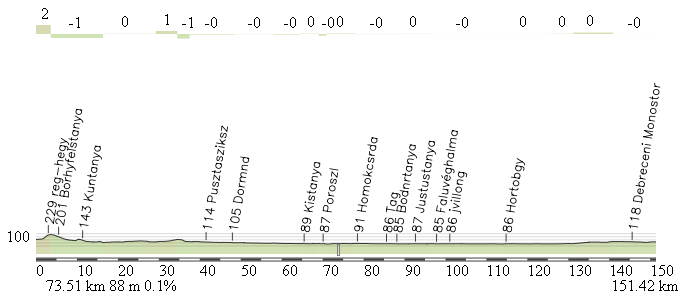
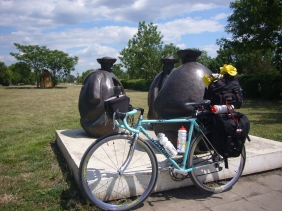
Hortobagy
Continuo sulla strada 3 che si allunga sulla pianura, non ci sono piú saliscendi e ci stiamo avvicinando alla Puszta. Lunghi tratti senza centri abitati, solo lo scarso traffico non mi fa patire troppa solitudine. Poco prima di Fuzesabony si lascia la strada 3 per la 33. Da Fuzesabony inizia una serie di rettilinei interminabili. Poco dopo Poroszlo si entra nel Parco naturale di Hortobagy e si attraversa il fiume Tibisco, un affluente del Danubio ed uno dei maggiori fiumi d’Europa. Nasce in Ucraina ed attraversa Ungheria, Romania, Slovacchia e Serbia. Il nome a me personalmente fa venire in mente fauni, ninfe e altri personaggi mitologici. La Puszta é infinita da tutti i lati la si guardi, non ci sono piú neanche i monti Matra che nella prima parte del percorso si stagliavano sulla sinistra. Ancora lunghissimi rettilinei, il tempo passa e il caldo aumenta, ma non sará mai eccessivo. Hortobagy é un kilometro di strada dove si trova tutto per il turista della Puszta. Dopo Hortobagy ci saranno 35km di rettilineo che portano dritti a Debrecen, la seconda cittá dell’Ungheria e la piú a est tra le grandi cittá.
![]() Road n.3 keeps going straight on the flatland, no more ups and downs, Puszta is not far away. Long parts of the road run in the countryside, no villages around, only light traffic not to feel too alone. Just before Fuzesabony you’ll leave road n.3 to take n.33. From Fuzesabony starts a long series of neverending (rettilinei), after Poroszlo the Hortobagy National parks begins crossing river Tisza, one of the most important rivers in Hungary and Europe. It starts in Ukraine crossing Ungary, Romania, Slovakia and Serbia before entering Danube. Puszta is endless everywhere, you don’t see mounts Matra that were visible in the first part of the route. The road is still straight, time runs and weather gets hotter, but it will be never too hot. Hortobagy village is a km of road with everything for Puszta turist. After Hortobagy 35km of straight road will take you in Debrecen, the second city of Hungary, the most eastern among large towns.
Road n.3 keeps going straight on the flatland, no more ups and downs, Puszta is not far away. Long parts of the road run in the countryside, no villages around, only light traffic not to feel too alone. Just before Fuzesabony you’ll leave road n.3 to take n.33. From Fuzesabony starts a long series of neverending (rettilinei), after Poroszlo the Hortobagy National parks begins crossing river Tisza, one of the most important rivers in Hungary and Europe. It starts in Ukraine crossing Ungary, Romania, Slovakia and Serbia before entering Danube. Puszta is endless everywhere, you don’t see mounts Matra that were visible in the first part of the route. The road is still straight, time runs and weather gets hotter, but it will be never too hot. Hortobagy village is a km of road with everything for Puszta turist. After Hortobagy 35km of straight road will take you in Debrecen, the second city of Hungary, the most eastern among large towns.
| 3 – 2/7: Debrecen – Satu Mare, 119km |
Visualizza balcani3 in una mappa di dimensioni maggiori
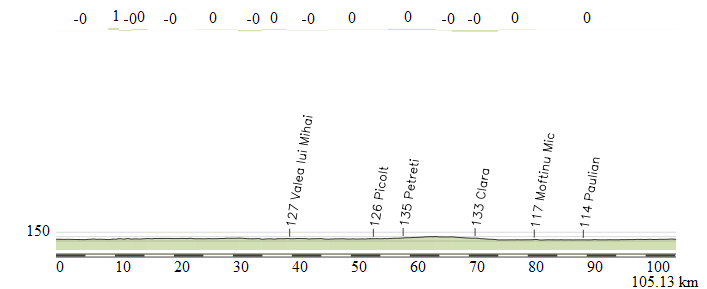
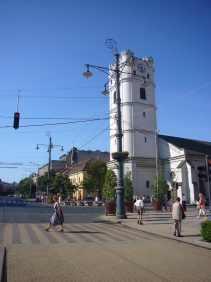
Debrecen
Lascio Debrecen attraversando il centro storico, con una grande e bella piazza chiusa al traffico. Si esce dalla città attraverso una periferia già calda alle 9 del mattino. Passo un paio di incroci senza semafori e senza regole, poi finalmente inizia Vamospercsi Utca, l’ultimo infinito rettilineo verso la frontiera con la Romania. La guardia di confine ungherese controlla il passaporto, nessuno dal lato rumeno. Sono appena entrato nel “profondo est”. La strada, che in Ungheria era perfetta, adesso potrà variare da “abbastanza buona” a “bombardata dieci minuti fa”. In generale l’asfalto è grezzo e irregolare ma accettabile, la velocità di crociera intorno ai 25km/h. Le strade principali sono abbastanza buone anche se le buche, pure larghe e profonde, non mancheranno. A dire il vero non mi è sembrato questo il problema, nel senso che se non si dorme alla guida si riesce ad evitarle facilmente. Prima di partire avevo letto vari report di viaggio in Romania dove uno degli argomenti principali erano questi “potholes”, le grosse buche sull’asfalto che sembravano costringere ad una guida a zig zag senza tregua. Bisogna essere molto vigili, ma non mi è sembrato questo il problema principale. Altro discorso sono le strade minori, ma questo lo vedremo tra qualche tappa. La Romania è in Europa, ma è difficile crederlo attraversando i piccoli centri rurali che danno a volte l’impressione di grande povertà. Sulla strada sarà normale incontrare carretti tirati da cavalli. Nonostante questo i centri abitati più grandi sono vivi e piacevoli, pur mantenendo il loro look sovietico. La prima cittadina che si incontra dopo il confine è Valea lui Mihai dove tra le altre cose è presente una banca dove è possibile cambiare il denaro per ottenere i Lei rumeni (San Paolo, a destra sulla strada principale poco dopo l’ingresso in città). Arrivo a Satu Mare e prendo alloggio all’Hotel Dana, alla prima periferia della città. Domani mattina farò un giro in centro prima di proseguire.

Villaggio in Romania – Village in Romania
![]() I leave Debrecen passing through a nice historical center with a large and beautiful square closed to traffic. The city surroundings are already hot at 9am. After few road crossings “no traffic lights-no rules” eventually Vamospercsi utca starts, the last endless straight road towards Romania border. The Hungarian guard checks my passport, nobody at Rumenian side. I just entered the “deep East”. The roads in Hungary were perfect, now they may vary from “quite good” to “bombed 10 minutes ago”. Asphalt is generally raw and irregulare but acceptable, cruise speed is about 25km/h. Main roads are quite good but big and deep holes may be found. To be honest I think that this is not a real problem; if you don’t sleep while driving, you will easily avoid them. Before leaving home I had read many travel reports in Romania where one of the main topics were the “potholes”, large holes on asphalt. You must be very careful and look the road but it did not seem to me the main problem. Something different are minor roads, but we will discuss abot them later. Romania is in Europe, but it is difficult to believe passing through small countryside villages that gives often the impression of great poverty. On the road will be normal to meet horse-carts. Larger cities are anyway interesting and nice, though their “soviet look”. The first city after border is Valea lui Mihai where you can also change money to get Romanian Lei (San Paolo Bank, on main road, right side just after entering city). I reach Satu Mare and stop at Dana Hotel (first suburbs on main road). I will take a short tour in city center tomorrow morning.
I leave Debrecen passing through a nice historical center with a large and beautiful square closed to traffic. The city surroundings are already hot at 9am. After few road crossings “no traffic lights-no rules” eventually Vamospercsi utca starts, the last endless straight road towards Romania border. The Hungarian guard checks my passport, nobody at Rumenian side. I just entered the “deep East”. The roads in Hungary were perfect, now they may vary from “quite good” to “bombed 10 minutes ago”. Asphalt is generally raw and irregulare but acceptable, cruise speed is about 25km/h. Main roads are quite good but big and deep holes may be found. To be honest I think that this is not a real problem; if you don’t sleep while driving, you will easily avoid them. Before leaving home I had read many travel reports in Romania where one of the main topics were the “potholes”, large holes on asphalt. You must be very careful and look the road but it did not seem to me the main problem. Something different are minor roads, but we will discuss abot them later. Romania is in Europe, but it is difficult to believe passing through small countryside villages that gives often the impression of great poverty. On the road will be normal to meet horse-carts. Larger cities are anyway interesting and nice, though their “soviet look”. The first city after border is Valea lui Mihai where you can also change money to get Romanian Lei (San Paolo Bank, on main road, right side just after entering city). I reach Satu Mare and stop at Dana Hotel (first suburbs on main road). I will take a short tour in city center tomorrow morning.
| 4 – 3/7: Satu Mare – Feresti, 130km |
Visualizza balcani4 in una mappa di dimensioni maggiori
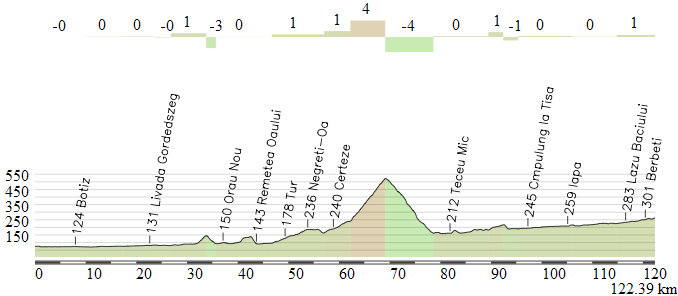
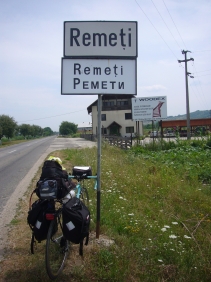
L’Ucraina è a un passo – Ukraine is a step away
La mattinata, appena sveglio, è buona, ma nel giro di un’ora il cielo si coprirà e nel momento esatto in cui tirerò fuori la bici dall’albergo inizierà a piovere. Decido di rimandare a un’altra occasione il giro nel centro di Satu Mare… Pioverà per almeno 45 minuti, non molto forte; il tempo poi migliorerà mantenendosi buono per il resto della giornata. Dopo Satu Mare la strada si inoltra nella campagnia via via più deserta; si attraversa qualche piccolo centro abitato. A Livada la strada avrà una biforcazione: si può proseguire direttamente per Baia Mare oppure andare a sinistra per Negresti Oas, dove mi dirigerò dal momento che il mio percorso vede come prossima tappa il Maramures, lo “Judetul” in cui la vita scorre ancora con ritmi arcaici.
Si attraversano alcuni centri abitati, il fondo stradale è scassatissimo in alcuni tratti, principalmente proprio nell’attraversare i paesini, poi subito migliora. Da Vama inizia la salita per il passo Huta-Certeze, il paesaggio è ora vario e collinare, molto più bello di prima dove abbiamo attraversato la pianura chiamata Campia Careilor. La salita si snoda su larghi tornanti, a volte sotto gli alberi. La pendenza è intorno al 5%. Sembra sempre di essere in cima, ma ad ogni curva si continua. Si scollina in corrispondenza del confine dello Judetul Maramures. La discesa è spettacolare, sotto un tunnel di alberi. La strada è perfetta ma sarà solo un’illusione: sembrava asfaltata di fresco e in effetti lo era, nel senso che dopo pochi km solo il lato destro sarà rinnovato e più avanti neanche quello, dato che incontrerò gli operai che lo stanno asfaltando. Bisogna quindi scendere con cautela, il fondo è di nuovo sconnesso e prendere una buca più profonda (ce ne sono tante) potrebbe essere fatale. Con un po’ di attenzione si riesce a mantenere una velocità discreta. Si attraversano alcuni abitati, sono molto modesti ma non danno l’impressione di vera e propria decadenza come il tratto precedente. Arrivo a Sapanta, dove è d’obbligo la sosta presso il “cimitero allegro”. Per strada ci sono galline a libero pascolo, carretti tirati da cavalli e anziane donne vestite di nero. Raggiungo Sighetu Marmatiei; questa è zona di frontiera, l’Ucraina è veramente ad un passo e alcuni centri abitati hanno il nome scritto anche in cirillico sui cartelli. Dopo Sighetu Marmatiei inizio a cercare un posto dove dormire. Troverò una pensiunea a circa 15 km, un posto molto caratteristico con un allegro arredamento pieno di tappeti e pelli di pecora, in un luogo eccezionalmente bello e tranquillo.

![]() The morning is fine but while I have breakfast the weather will get worse and exactly when I’ll take the bycicle out the hotel it starts raining. I decide to delay my tour in Satu Mare someday in the future… It will rain for 45 minutes, not very hard. The weather will get better and will be fine the rest of the day. After Satu Mare the road enters a desert countryside, sometimes a little village. In Livada you can choose to follow the direct road to Baia Mare or left to Negresti Oas. This is my travel path to Maramures, the “Judetul” where time runs at archaic rithms. Sometimes you’ll find small villages, the road pavement is very bad especially while passing through villages, then gets better. From Vama starts the ascent to Huta-Certeze pass and the landscape is now various and hilly, much more beautiful than before where we run across the Campia Careilor flatland.
The morning is fine but while I have breakfast the weather will get worse and exactly when I’ll take the bycicle out the hotel it starts raining. I decide to delay my tour in Satu Mare someday in the future… It will rain for 45 minutes, not very hard. The weather will get better and will be fine the rest of the day. After Satu Mare the road enters a desert countryside, sometimes a little village. In Livada you can choose to follow the direct road to Baia Mare or left to Negresti Oas. This is my travel path to Maramures, the “Judetul” where time runs at archaic rithms. Sometimes you’ll find small villages, the road pavement is very bad especially while passing through villages, then gets better. From Vama starts the ascent to Huta-Certeze pass and the landscape is now various and hilly, much more beautiful than before where we run across the Campia Careilor flatland.

The ascend runs on large curves, often under the trees. The steep is about 5%, at every turn it seems to be finished but the road continues again. The top of the hill is at border with Maramures Judetul. Descent is great, under a tunnel of trees. Road is perfect but it will reveal to be an illusion: it seemed to be just asphalted, and actually it was. After few kms only right side of the road is new, then I will meet the road workers. Great care is requested, there are many holes and getting one of them at high speed might be fatal. Villages are poor-looking but they not seem so bad as before. In Sapanta a stop is due at “Cheerful cemetery”. Along the road there are lot of chickens, carts and old women dressed in black. I get Sighetu Marmatiei, this is border zone, Ukraine is really a step away and some villages have the name written in cyrillic on road signs. I find a place to sleep 15 km after Sighetu Marmatiei, a “pensiunea” very nice with lot of carpets and sheep wool in an extremely peaceful and nice place in the countryside.